Josef Kote Painting
The paintings of J. Kote are symphonies of light and color. They are lyrically stunning and romantic, edgy and current. Kote achieves this delicate balance of seemingly contradictory qualities through his complete mastery in technique, and through years of experimenting to find his own unique style.
Josef Kote paintings are symphonies of light and color. They are lyrically stunning and romantic, edgy and current. Kote achieves this delicate balance of seemingly contradictory qualities through his complete mastery in technique, and through years of experimenting to find his own unique style.
With the lightness of a true master’s hand he combines classic academic and abstract elements, fusing these, literally letting them run into each other with dripping rivulets of riveting colors and light. : by using his signature drip effect along the bottom. His official website: JKConceptualArt.com
”Art to me is so special. It’s a passion and purpose; it is the essence of my being” ─ Josef Kote
Kote’s trade marks are his bold brush work and sweeping strokes of vibrant colors applied – more often than not – with a pallet knife, while other areas of the canvas are left monochromatic and devoid of detail creating a negative space that lets the eye drift to infinity.
The results are paintings that tremble in stillness with energy and light.
Influenced by many places where he lived, Albanian born artist J.Kote began his journey towards artistic self-discovery in his youth and never looked back. From very young age he was endlessly drawing and had the innate urge to create.
By the age of 13 he had made up his mind to become an artist and devote his life to the arts.
Education and Career
He focused on getting accepted into the finest art high school of his native Albania. Ultimately, after competing locally and nationally, he was awarded a coveted spot at ‘’National Lyceum of Arts’’ in Tirana.
In 1984 Kote followed this amazing feat by being accepted into the ‘’Academy of Fine Arts’’ of Tirana, where J.K was educated in the traditional approach of the old masters.
Yet even as a student he wanted to brake loose of the limitations, he wanted to experiment and grow, sometimes leave paintings seemingly unfinished, shatter the boundaries of classic realism. While still in school Kote also worked at a movie studio, and made a small but well received animation film Lisi.
In 1988 Kote graduated with a diploma in painting and scenography. The years of practice and his 8 year solid art education had prepared the young artist well to pursue his life’s quest of living and breathing art.
Chasing A Vision
Written by; Emma Laramie
Works at Christie’s
Unsurprisingly, it was these eight years of training that gave Kote the basis for everything he has done throughout his career, whether he is embracing it fully or attempting to subvert it. At the Academy of Fine Arts, a curriculum based in the traditions of the Old Masters got him thinking of the many ways painting’s reach could extend even further. Pure realism, as his oeuvre makes abundantly clear, was never wholly satisfactory for Kote.
Instead, it appears his desire was, and remains, to update classical realism for his modern viewers, incorporating the artistic innovations of the past century, namely abstraction. In doing so, Kote arrived at his signature blend of these two dominant themes in painting, taking the parts of each that serve him best and discarding the rest. As such, he challenges not only himself, but the very limits of painting, an experiment that has been at the forefront of artistic innovation for centuries.
Upon graduating, Kote’s career as an artist began with almost lightning speed. He began working as a scenographer for the Petro Marko Theatre in Vlore, a theatre as well known for its scenography as it is known for its performances. After a time of working at the theatre, Kote grew restless, and in the late 1990s, at twenty-six years old, he moved to Greece. This move would begin an almost nomadic pattern in his life, as Kote would travel from Albania to Greece to Toronto, finally resting in New York.
If the evolution of Kote’s art could be defined by one thing, it would undoubtedly be this concept of place. A restless spirit, his life has taken him all around the world, not only to various cities, but to different countries and regions. Each time his location shifts, so too does his style.
A landscape painter at heart, although drawn to many other facets of life itself that undoubtedly appear in his work, it is as if his changes of scenery perfectly coincide with this artistic practice. As soon as he begins to feel he has taken all he can from one location, it is on to another place, another source of inspiration.
In fact, one of his primary goals as an artist is, “the need to push the boundaries of [his] previous work, explore new areas, and experiment with colors and concepts by looking beyond the ordinary paths. It’s really about taking a risk while painting so that [he] can create something that [he] hadn’t fathomed before.” In each location, during each day, colors and light shift and dance in their own unique ways, defining these spaces, and subsequently, Kote’s paintings.
While each painting is decidedly different from the next, they each begin in much the same way. Kote has a daily practice, working long hours every day. Gathering inspiration from nature and the things around him, he will often make sketches en plein air to quickly capture what around him has taken hold of his imagination.
It is therefore logical that place would be so important to a painter like Kote, for each minute element of the surrounding world can provide bountiful arrays of inspiration. That is not to say that each painting happens quickly. While undoubtedly an incredibly prolific artist, he will sometimes think on a subject for months at a time before finally understanding the direction he wants to move his subject towards. As he says:
”A good subject matter for me is anything that haunts my mind and lingers from the moment that I see it. When something stays with me despite the distractions of ordinary life, I know that it is powerful. This can be a range of subjects. Over the years, I’ve painted landscapes, portraits, cityscapes, and marine art. As I’ve grown, different things have inspired me and caught my attention.”
Most paintings will begin with some sort of sketch, with the degree of compositional exactitude dependent upon each subject at hand. After working through this initial design, and determining the proper size and layout, Kote will utilize a few quick strokes to begin to bring the composition to life.
It is at this stage that values and colors begin to take hold, grounding the rest of the painting. At this point, the painting process becomes “exciting and unpredictable,” for no matter how thought out it may be, the painting is at the mercy of Kote’s emotions as he works through the canvas.
Once this initial groundwork is completed, Kote likes to start with a singular focal point, usually the primary subject of his work. This is, naturally, often the most “finished” part of the work, the part that is most established in realism. The composition is then built outwards from this focal point, and finally tied together with expressive flourishes of brushstrokes and more exacting details.
These portions blend effortlessly together, in part through his signature “dripping effect,” in which he lets rivulets of color drip on to the canvas and freely flow into each other, creating a chance dance between two colors, blending two elements together.
Beyond this, Kote is well known for his implementation of both brush and palette knife, which allows for a range of different textures, and lends itself well to his desire to create something both expressive and impressionistic. The palette knife is most commonly used in his paintings to create the sweeping strokes of bold, pulsating color that moves throughout each and every one of his canvases. Yet equally important are the areas of the composition Kote chooses not to paint, or at least, to not paint so heavily.
These monochromatic areas are simple, almost devoid of detail, and in their sparseness, remind their viewers of the world beyond the scene at hand. By creating this moment of simplicity, Kote invokes a quiet stillness that echoes throughout the entirety of his painting. As a result, each of his works, but especially his landscapes, feel strangely familiar, like a memory you can’t quite place drifting in and out of focus. It is as if time is irrelevant in these scenes, existing simultaneously in the past and future.
Those more unfamiliar with art may largely think of its styles as distinctly broken up – realism versus abstraction, modernism versus classicalism, and so on ad infinitum. While this is never wholly true, Kote is uniquely adept at blending each of these seemingly disparate elements into one singular painting, allowing the strengths of each to complement one another.
Indeed, his time at school in Albania may largely be to thank for this ability. With a training rooted in the classical tradition of the Old Masters, Kote was keen to break free from their rigidity, adding his own personal flourishes to his paintings that bring them in to the modern world.
Upon moving to Greece at the age of twenty-six, Kote’s work embraced his lush Mediterranean surroundings. The soft glow of the sun, and the slower tempo of life there were echoed in the warmth and calmness of his paintings. These natural surroundings would have been a perfect outlet for Kote to hone and perfect his now signature techniques.
Yet it was also the period in his career in which Kote produced his most structured works of art, as he was granted the opportunity to paint two modern moments of Greece’s rich and long history. The first, done in 1998, is known as The Meeting of the Leaders. Commissioned for the Hellenic Cultural Union in Thessaloniki, it depicts the assembly of the founders of modern Greece. A more traditional painting than what Kote is known for, likely drawn largely from his classical training in school, it holds much of the gravitas of a conventional state painting.
After a fruitful ten years in Greece, Kote again grew restless. Kote made his way to Canada, where he stayed for almost a decade. Once again, Kote’s daily surroundings provided countless sources of inspiration. Known for its harsh and intense winters, this period of his oeuvre reflects the snowy landscapes of the Great White North.
Amidst the expanse of snowy ground, thin tree trunks spring up, almost entirely bare the closer to the viewer they appear. Extending from the top to the bottom of the canvas, they anchor the composition, filling out as the viewer’s eyes move further into the landscape. In these sections, onlookers get a glimpse of Kote’s other signature techniques – his dripping effect and his expressionistic brushwork.
Then, in 2009, Kote moved again, this time to New York. Like so many artists before him, and so many that will follow after, he was inspired by the vibrancy and energy of the city, and this was channeled into the work that he has produced over the near decade he has lived there.
While Kote strives to create a definitively unique style that is undoubtedly his own, he is not without certain art historical precedents. Indeed, this is part of what makes Kote such an adept painter – by taking what has come before him and transforming it into a style that is inherently tied to him as an artist, he manages to fulfill his own unique needs while simultaneously driving the long and complex history of painting further into new realms.
Looking at Kote’s work, two distinct ideas in art history come to the fore: that of abstraction versus realism, and the notion of painting as representative of feeling or experiences. Much of the way we view these ideas in art now, and much of the way Kote works, can find their beginnings at the end of the nineteenth century with the Impressionists.
A result of multiple social, economic, and artistic factors, such as the Industrial Revolution and the invention of ready-to-purchase tubed oil paints, the Impressionists began to see and depict their ever-changing surroundings in increasingly new and inventive ways. Working en plein air as a result of these new innovations in paint production, as Kote himself so often does, artists such as Monet, Renoir, and Van Gogh began to focus less on the specifics of the landscape around them.
Instead, their interests lived in the in-between moments, in the states of flux that the world constantly exists in, as the name of the movement implies. In much the same way, Kote does not give his viewers exacting, clear details. Instead, he lets the general impression of the scene that has inspired him – whether a seascape, or a moment of his daughter – guide his brush.
By not relaying the minutiae of these moments, Kote, like the Impressionists, allows his viewers ample space to fill in the missing elements, to evoke their own feelings and to understand the fleeting nature of these moments that we can only attempt to keep forever in paint.
This radical departure from the tradition of art history that had pervaded painting for hundreds of years captured the minds of more than just the Impressionists or Kote, and it can also be plainly seen in Kote’s oeuvre the multitude of ways these further inventions in abstraction and emotive depictions have influenced him.
Wassily Kandinsky, perhaps the first true abstract painter, has a number of similarities and influences as Kote. Most notable of these is the influence music has on both artists. Kandinsky viewed music as the most transcendent form of art, and his life’s work was in large part an attempt to create a similar effect that sound produces in paint.
From titling his works in ways that hinted at music, such as his series of “Compositions” or “Improvisations,” to the very compositions themselves, springing forth with energetic lines that look almost like notes on a musical staff and colors that harmoniously flow together like chords, music was in everything Kandinsky did.
In much the same way, Kote is deeply inspired by music, which has played a key role in his life. Starting music lessons at age twelve, Kote toyed with the idea of becoming a musician, before discovering painting and shifting his career plans.
To this day, he spends much of his time in the studio listening to classical music as he paints, and he cites this as an instrumental part of his creative process.
Moving in to today’s artistic landscape, few artists work in a style quite like Kote’s, but one artist that continually comes to mind is the artist Peter Doig. Scottish-born and Trinidadian-based, Doig, like Kote, has constantly moved around the world, and these varying landscapes and the memories they provide continually influence his work.
A remarkable force of a painter, Kote’s singular artistic vision has managed to sustain him for his entire career, providing a deep, rich and prolific body of work. Forever inspired by the world around him, he has shown keen insight into the nature of existence and given viewer’s a unique opportunity to contemplate and appreciate their surroundings, seeing them in a new and fresh way. As with any artist, Kote will undoubtedly continue to grow and flourish, and it will be nothing short of exciting to see where this takes him.

The paintings of J. Kote are symphonies of light and color. They are lyrically stunning and romantic, edgy and current. Kote achieves this delicate balance of seemingly contradictory qualities through his complete mastery in technique, and through years of experimenting to find his own unique style.

With the lightness of a true master’s hand he combines classic academic and abstract elements, fusing these, literally letting them run into each other with dripping rivulets of riveting colors and light. : by using his signature drip effect along the bottom. His official website: JKConceptualArt.com

Kote’s trade marks are his bold brush work and sweeping strokes of vibrant colors applied - more often than not - with a pallet knife, while other areas of the canvas are left monochromatic and devoid of detail creating a negative space that lets the eye drift to infinity. The results are paintings that tremble in stillness with energy and light.

Influenced by many places where he lived, Albanian born artist J.Kote began his journey towards artistic self-discovery in his youth and never looked back. From very young age he was endlessly drawing and had the innate urge to create. By the age of 13 he had made up his mind to become an artist and devote his life to the arts.
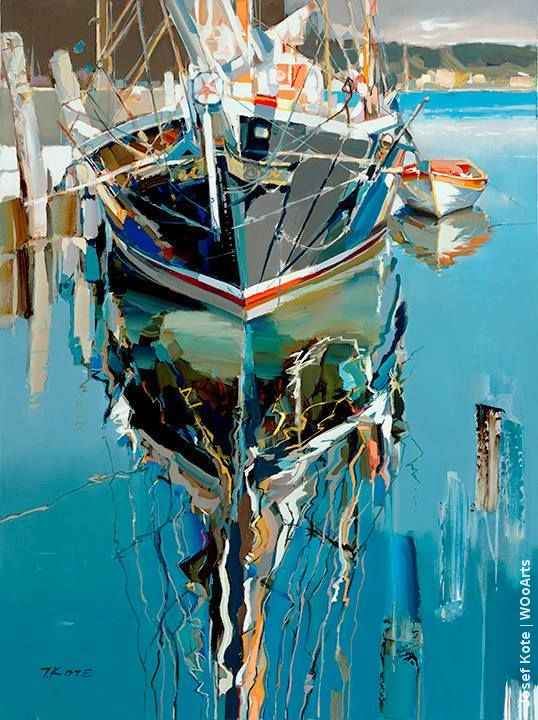
Education and Career: He focused on getting accepted into the finest art high school of his native Albania. Ultimately, after competing locally and nationally, he was awarded a coveted spot at ‘’National Lyceum of Arts’’ in Tirana. In 1984 Kote followed this amazing feat by being accepted into the ‘’Academy of Fine Arts’’ of Tirana, where J.K was educated in the traditional approach of the old masters. Yet even as a student he wanted to brake loose of the limitations, he wanted to experiment and grow, sometimes leave paintings seemingly unfinished, shatter the boundaries of classic realism. While still in school Kote also worked at a movie studio, and made a small but well received animation film Lisi.

In 1988 Kote graduated with a diploma in painting and scenography. The years of practice and his 8 year solid art education had prepared the young artist well to pursue his life’s quest of living and breathing art. It had set him on his lifelong journey to find his own unique style and language, to create stupendous paintings pulsating with the light and energy that he sees all around him. Kote began his professional career as a scenographer at the Petro Marko Theatre in Vlore, but in late 90-s the 26 year old artist grew restless and decided to debark to Greece, where the warmth of the Mediterranean sun and brilliant light infused his paintings in tone and style and lent them a more impressionistic air.

Highly respected, the young artist did well and received many important commissions, including: In 1998 The Meeting of the Leaders for the Hellenic Cultural Union in Thessaloniki which depicted the Assembly of the Founders of Modern Greece, A portrait in 2000 of the former president of Greece, Konstantinos Stephanopoulos, for the Greek community in Toronto.

Going Abroad to International Viewers After a very successful 10 years in Greece, Kote was weary to rest on his laurels, and he moved to Toronto. Already renowned for his beautiful portraits and scenic paintings, Kote now garnered additional kudos for his gorgeous urban scapes, and snow scenes. His color and style moved away from the impressionistic influence toward a more expressionistic feel. The paintings from this period, many of them masterpieces, are a clear indication of the continual development of Kote’s style and his fluidity and growth as an artist. Thanks to a host of avid collectors worldwide Kote saw his dream and years of labor come to fruition. Achieving this goal, however, only made him strive for higher ones.
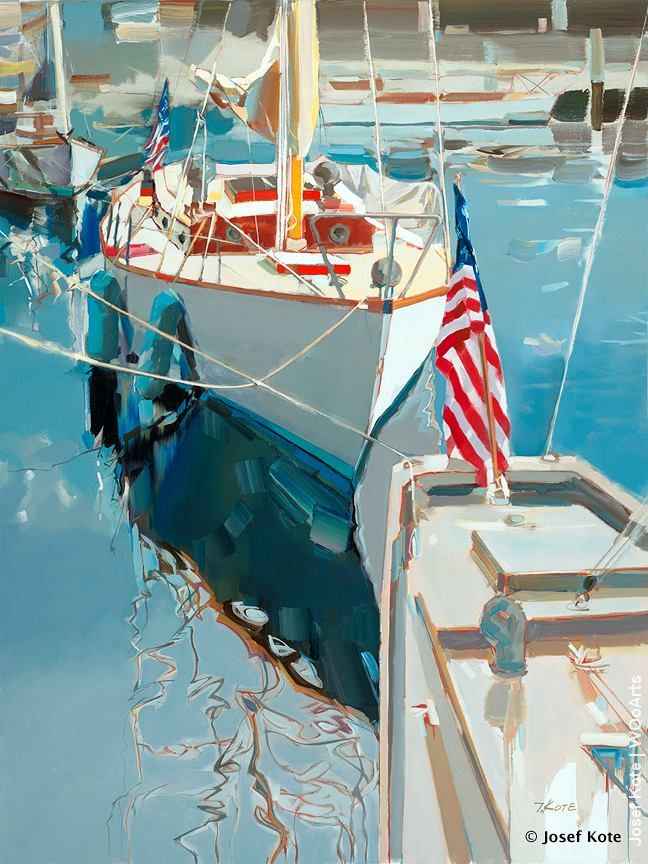
Like a rolling stone Kote moved to New York, The Big Apple, in 2009. Here his paintings and style morphed again. The colors grew bolder and his style became so unique that it cannot be ascribed to an existing genre. This highly prolific painter, who works on his craft almost daily and long hours, is never satisfied, always seeking, always experimenting, and always growing. Only the future will reveal the great heights his art will ascend. Certainly one thing holds true for all of Kote’s master works: they capture shimmering moments in time and space and are filled with light, energy and love for whatever subject he chooses to portray. By : Diana Pinck | Art and Travel Writer | 25 A Magazine

CHASING A VISION Written by; Emma Laramie Works at Christie's Master of Arts (M.A.), Modern and Contemporary Art and the Market To look at the work of artist Josef Kote is to see a memory, thought to be long forgotten, slowly coming back in to focus. It is to feel the dynamism of a taxi whizzing down the streets of New York, or to revel in the cool serenity of a snowy Canadian landscape. It is, in a sense, to be transported somewhere else. An abundantly prolific artist, Kote has spent his three-decade long career chasing a vision that he can set down on canvas.

Constantly challenging himself, his talents rest not only in his choice of subject matter - the landscapes and people that continually inspire him - but in his own inventive technique and style, a combination of classical training and modern day attitudes.Josef Kote was born in Albania in 1964. Unlike most children, who spend their childhoods wondering what they will be when they grow up, Kote knew from the young and innocent age of thirteen that he wanted to be a painter.

Again, unlike most other people, this decision is one that he has never wavered from, instead using it as a driving force to propel him forward. Only a year after making this decision, at fourteen years old, Kote entered and won a national painting competition in Albania.

By winning, he was allowed entry into the National Lyceum of Arts in Tirana, where he began to train professionally as an artist. A few years later, in 1984, Kote’s talents again granted him access to the prestigious Academy of Fine Arts in Tirana, where he graduated with a degree in painting and scenography in 1988.

Unsurprisingly, it was these eight years of training that gave Kote the basis for everything he has done throughout his career, whether he is embracing it fully or attempting to subvert it. At the Academy of Fine Arts, a curriculum based in the traditions of the Old Masters got him thinking of the many ways painting’s reach could extend even further. Pure realism, as his oeuvre makes abundantly clear, was never wholly satisfactory for Kote.

Instead, it appears his desire was, and remains, to update classical realism for his modern viewers, incorporating the artistic innovations of the past century, namely abstraction. In doing so, Kote arrived at his signature blend of these two dominant themes in painting, taking the parts of each that serve him best and discarding the rest. As such, he challenges not only himself, but the very limits of painting, an experiment that has been at the forefront of artistic innovation for centuries.

Upon graduating, Kote’s career as an artist began with almost lightning speed. He began working as a scenographer for the Petro Marko Theatre in Vlore, a theatre as well known for its scenography as it is known for its performances. After a time of working at the theatre, Kote grew restless, and in the late 1990s, at twenty-six years old, he moved to Greece. This move would begin an almost nomadic pattern in his life, as Kote would travel from Albania to Greece to Toronto, finally resting in New York.

If the evolution of Kote’s art could be defined by one thing, it would undoubtedly be this concept of place. A restless spirit, his life has taken him all around the world, not only to various cities, but to different countries and regions. Each time his location shifts, so too does his style.

A landscape painter at heart, although drawn to many other facets of life itself that undoubtedly appear in his work, it is as if his changes of scenery perfectly coincide with this artistic practice. As soon as he begins to feel he has taken all he can from one location, it is on to another place, another source of inspiration.
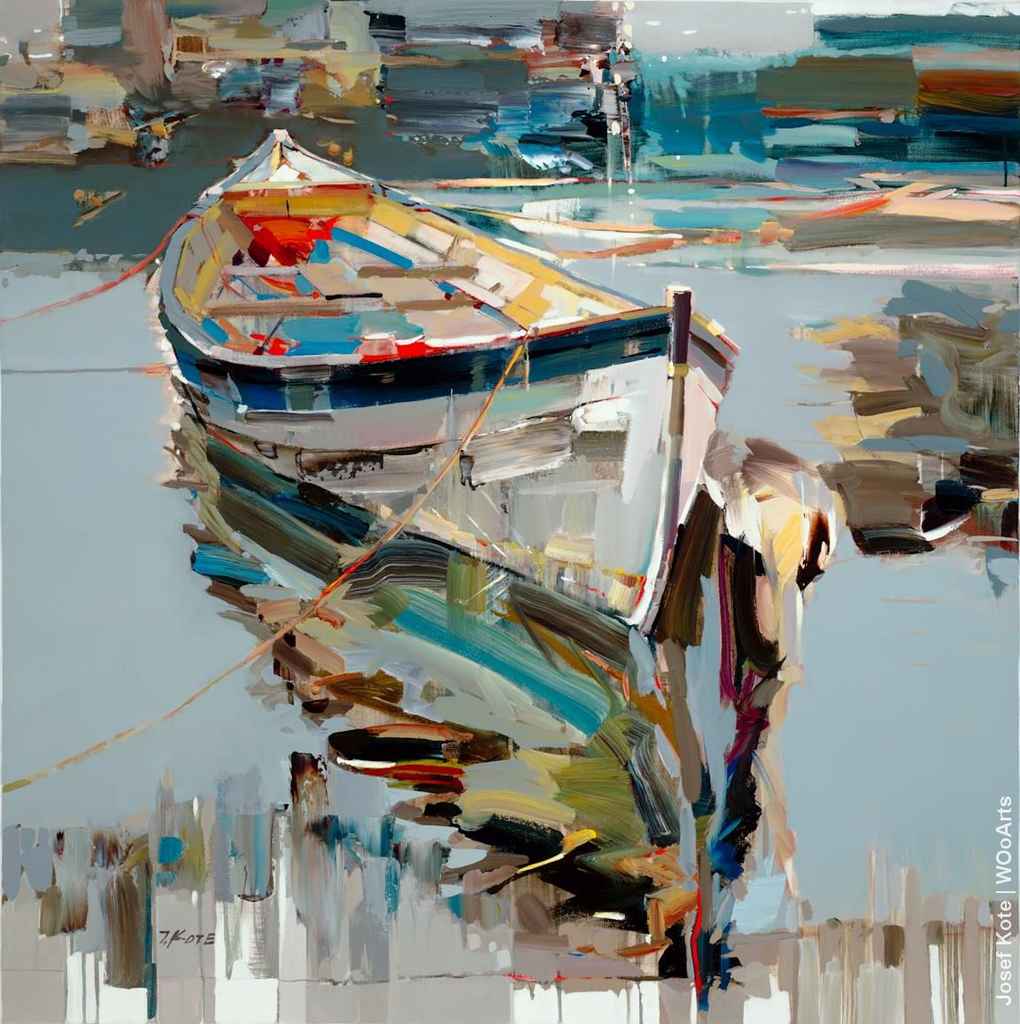
In fact, one of his primary goals as an artist is, “the need to push the boundaries of [his] previous work, explore new areas, and experiment with colors and concepts by looking beyond the ordinary paths. It’s really about taking a risk while painting so that [he] can create something that [he] hadn’t fathomed before.” In each location, during each day, colors and light shift and dance in their own unique ways, defining these spaces, and subsequently, Kote’s paintings.

While each painting is decidedly different from the next, they each begin in much the same way. Kote has a daily practice, working long hours every day. Gathering inspiration from nature and the things around him, he will often make sketches en plein air to quickly capture what around him has taken hold of his imagination.

It is therefore logical that place would be so important to a painter like Kote, for each minute element of the surrounding world can provide bountiful arrays of inspiration. That is not to say that each painting happens quickly. While undoubtedly an incredibly prolific artist, he will sometimes think on a subject for months at a time before finally understanding the direction he wants to move his subject towards. As he says:
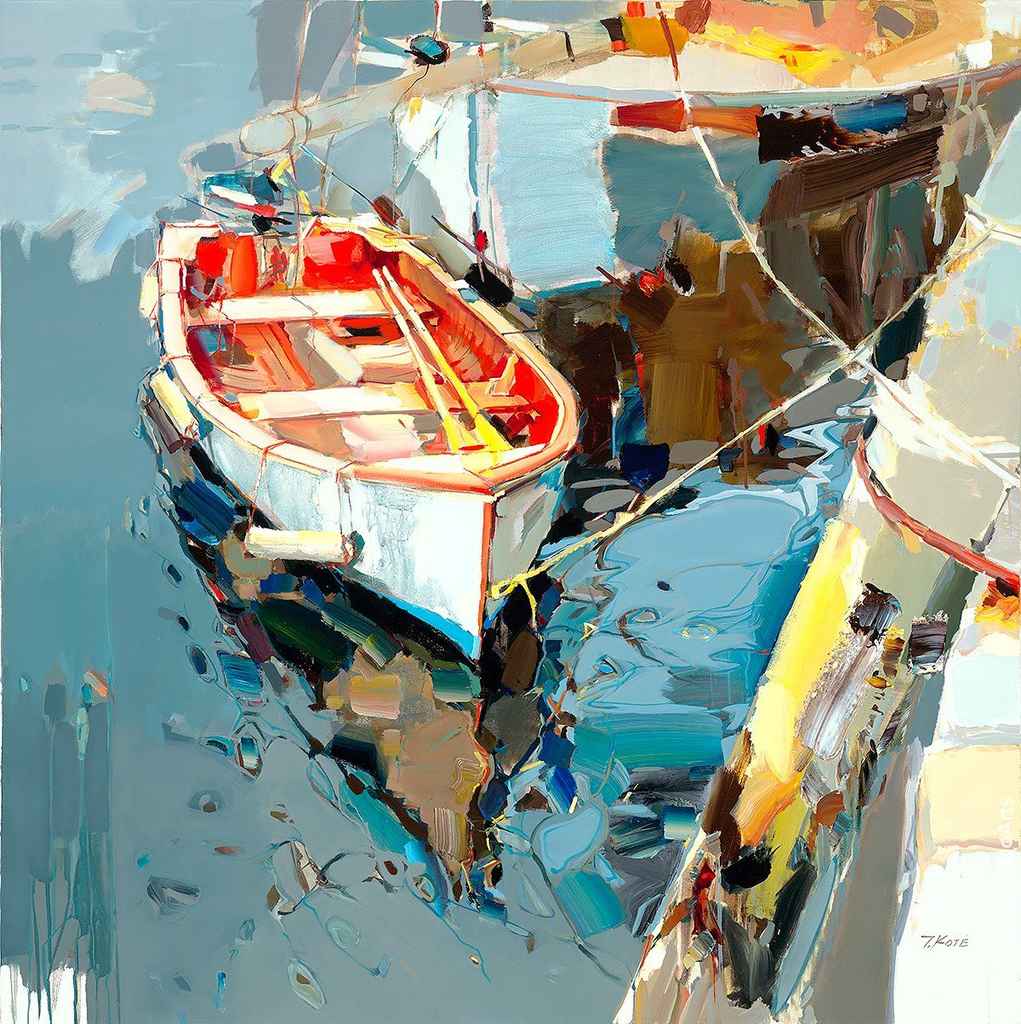
''A good subject matter for me is anything that haunts my mind and lingers from the moment that I see it. When something stays with me despite the distractions of ordinary life, I know that it is powerful. This can be a range of subjects. Over the years, I've painted landscapes, portraits, cityscapes, and marine art. As I've grown, different things have inspired me and caught my attention.''
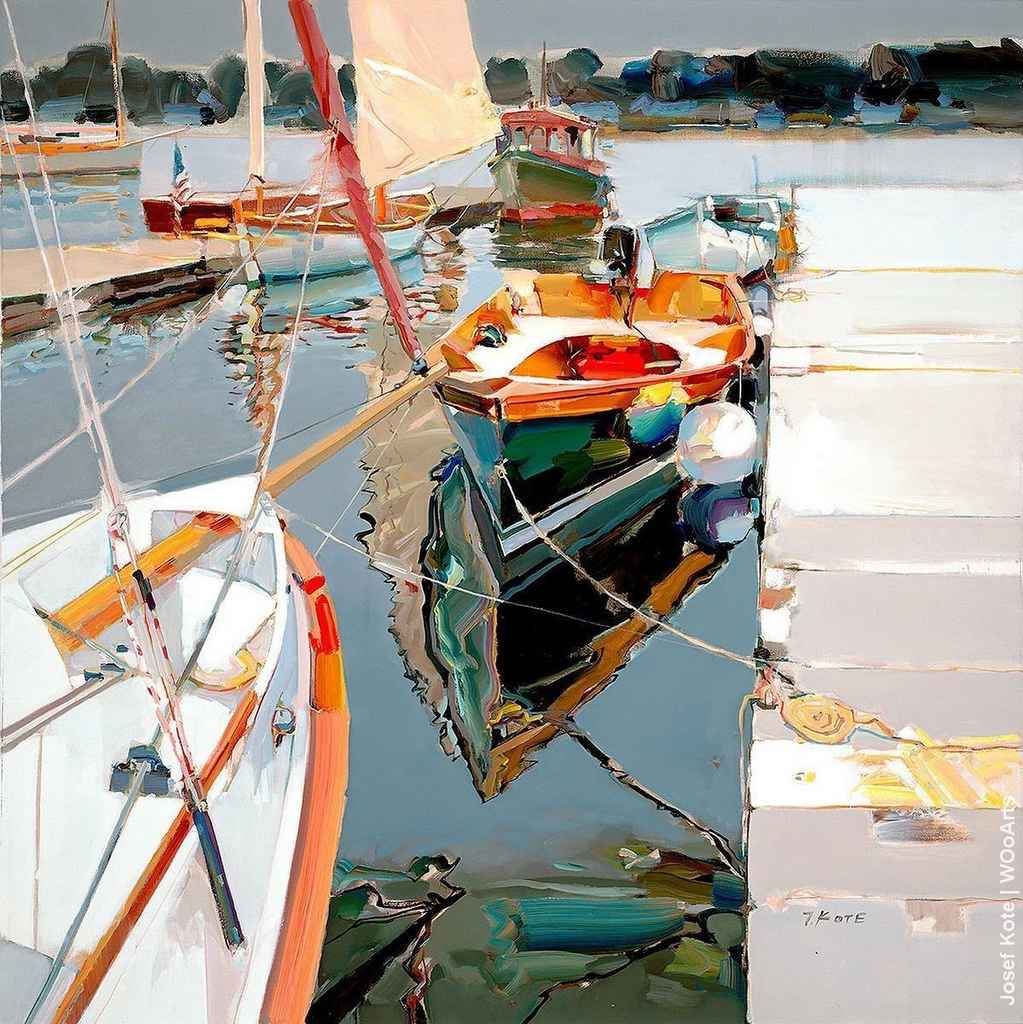
Most paintings will begin with some sort of sketch, with the degree of compositional exactitude dependent upon each subject at hand. After working through this initial design, and determining the proper size and layout, Kote will utilize a few quick strokes to begin to bring the composition to life.

It is at this stage that values and colors begin to take hold, grounding the rest of the painting. At this point, the painting process becomes “exciting and unpredictable,” for no matter how thought out it may be, the painting is at the mercy of Kote’s emotions as he works through the canvas.

Once this initial groundwork is completed, Kote likes to start with a singular focal point, usually the primary subject of his work. This is, naturally, often the most “finished” part of the work, the part that is most established in realism. The composition is then built outwards from this focal point, and finally tied together with expressive flourishes of brushstrokes and more exacting details.

These portions blend effortlessly together, in part through his signature “dripping effect,” in which he lets rivulets of color drip on to the canvas and freely flow into each other, creating a chance dance between two colors, blending two elements together.

Beyond this, Kote is well known for his implementation of both brush and palette knife, which allows for a range of different textures, and lends itself well to his desire to create something both expressive and impressionistic. The palette knife is most commonly used in his paintings to create the sweeping strokes of bold, pulsating color that moves throughout each and every one of his canvases. Yet equally important are the areas of the composition Kote chooses not to paint, or at least, to not paint so heavily.
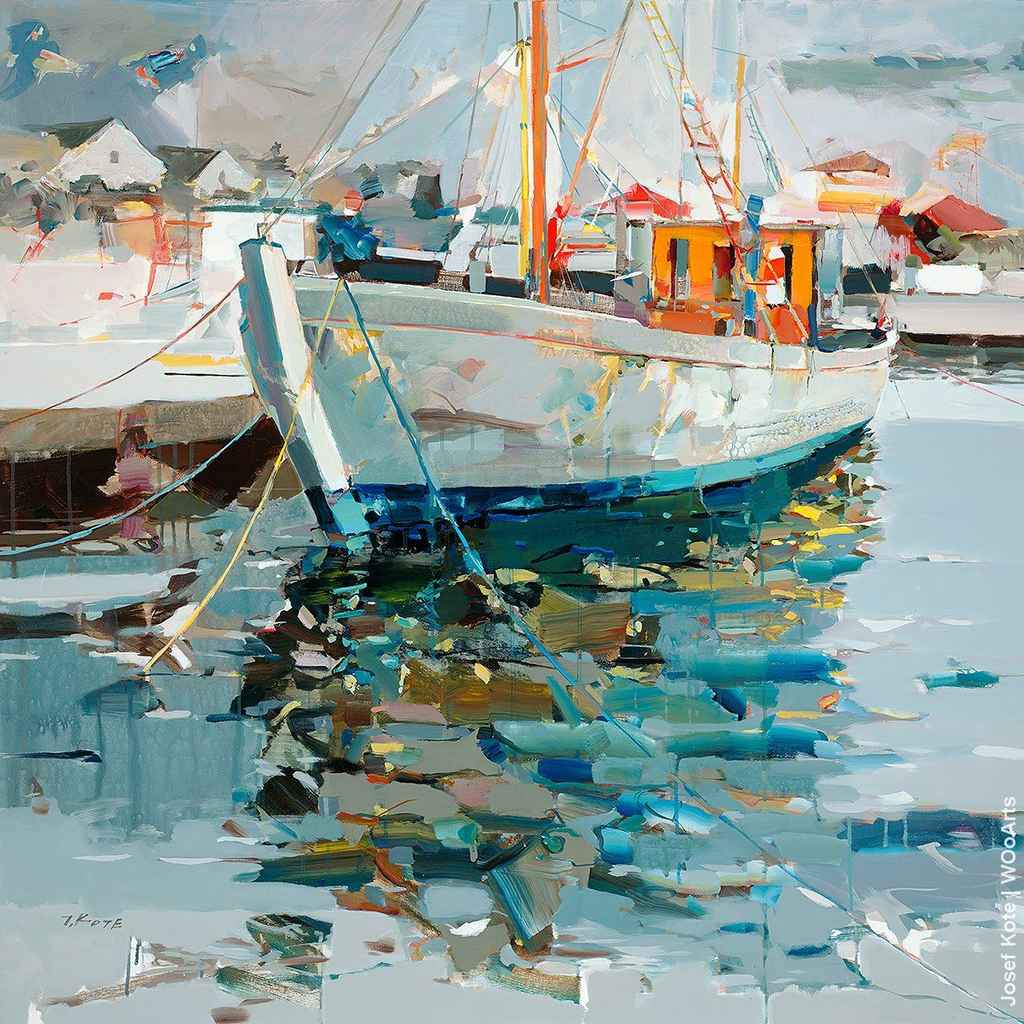
These monochromatic areas are simple, almost devoid of detail, and in their sparseness, remind their viewers of the world beyond the scene at hand. By creating this moment of simplicity, Kote invokes a quiet stillness that echoes throughout the entirety of his painting. As a result, each of his works, but especially his landscapes, feel strangely familiar, like a memory you can’t quite place drifting in and out of focus. It is as if time is irrelevant in these scenes, existing simultaneously in the past and future.

Those more unfamiliar with art may largely think of its styles as distinctly broken up – realism versus abstraction, modernism versus classicalism, and so on ad infinitum. While this is never wholly true, Kote is uniquely adept at blending each of these seemingly disparate elements into one singular painting, allowing the strengths of each to complement one another.

Indeed, his time at school in Albania may largely be to thank for this ability. With a training rooted in the classical tradition of the Old Masters, Kote was keen to break free from their rigidity, adding his own personal flourishes to his paintings that bring them in to the modern world.

Upon moving to Greece at the age of twenty-six, Kote’s work embraced his lush Mediterranean surroundings. The soft glow of the sun, and the slower tempo of life there were echoed in the warmth and calmness of his paintings. These natural surroundings would have been a perfect outlet for Kote to hone and perfect his now signature techniques.

Yet it was also the period in his career in which Kote produced his most structured works of art, as he was granted the opportunity to paint two modern moments of Greece’s rich and long history. The first, done in 1998, is known as The Meeting of the Leaders. Commissioned for the Hellenic Cultural Union in Thessaloniki, it depicts the assembly of the founders of modern Greece. A more traditional painting than what Kote is known for, likely drawn largely from his classical training in school, it holds much of the gravitas of a conventional state painting.

The Meeting of the Leaders c.1998 Oil on Linen, Private Collection, Athens, Greece In The Meeting of the Leaders, red curtains are pulled back to reveal fifteen men gathered to discuss the fate of Greece. Each one looks regal and stately in his own way, with dapper suits and full beards; some are even adorned with medals and military dress. The deep red of the curtains connects each element of the foreground, as it colors both the carpet underneath their feet and the tablecloth which rests in the center of the composition.

What is curious here, and what will be a continuing thread in Kote’s portraiture, is that none of the men lock eyes with each other, or with the viewer. Instead, each one seems deep in thought, pondering the future of their country. While it gives each of them a uniqueness and a sense of intrigue, it also highlights Kote’s interest in conveying feelings and ideas rather than actions. Certainly, an event as momentous as the founding of modern Greece as we know it today is one that is deserving of a healthy dose of reflection.

Behind them, elements of antiquity and modernism fuse together, another metaphor for Kote’s oeuvre on a larger scale. A sports stadium flanked by Corinthian columns extends the viewer’s eye towards the classical Greek architecture that dots the landscape behind them, making way for the zenith of all that is emblematic of ancient Greece: the acropolis. Standing high above the rest of the architecture, it recedes into the distances as a new, modern Greece emerges.

While this may not be the most typical of Kote’s work, it undoubtedly illustrates his masterful technique and innate abilities to convey meaning while possessing an adept ability to move between styles.
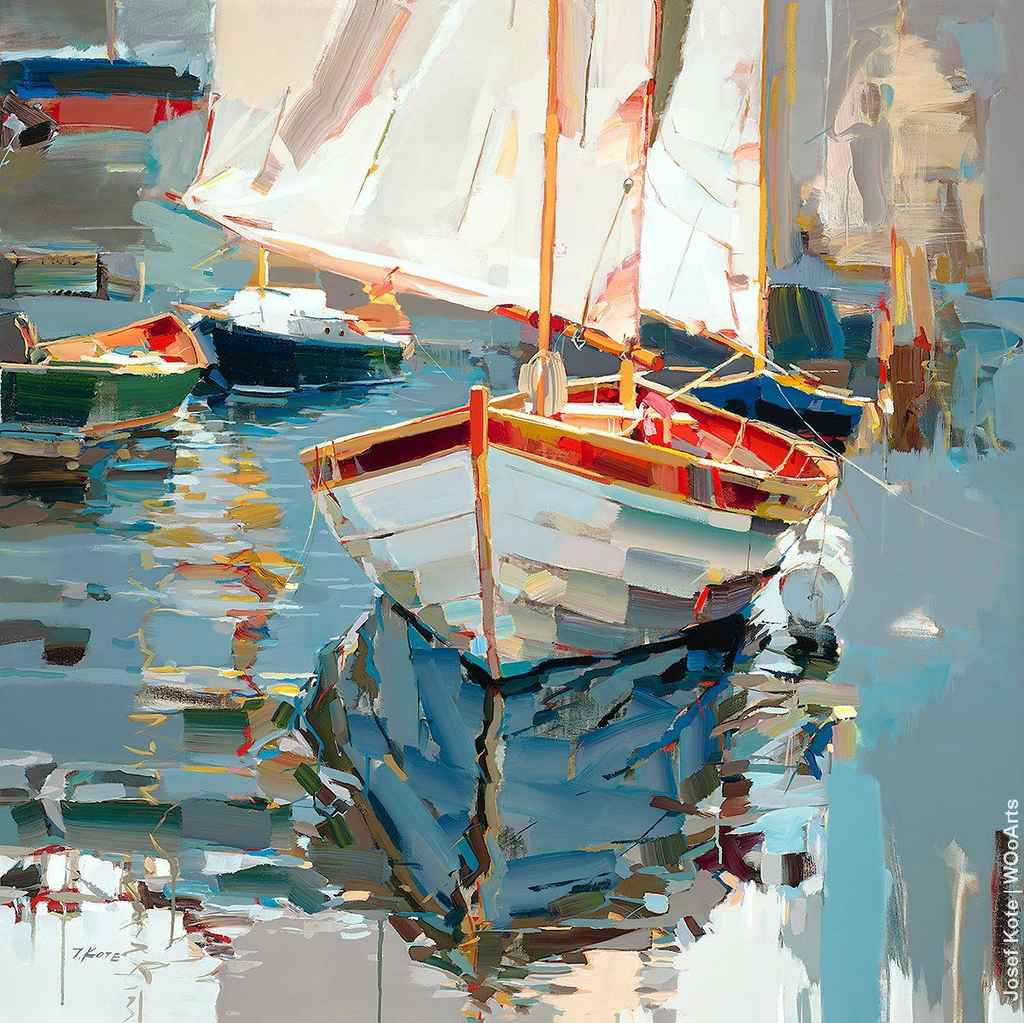
Portrait of Konstantinos Stephanopoulos c.2000 Oil on Linen Private Collection, Athens, Greece The second of the two commissions from this time is the portrait Kote did in 2000 of the then president of Greece, Konstantinos Stephanopoulos.

Done for the Greek community of Toronto, it is as stately as The Meeting of the Leaders, yet with the more personal touches Kote has come to be revered for. Stephanopoulos sits crossed legged in a striped chair, his hands resting softly on top of his knees.
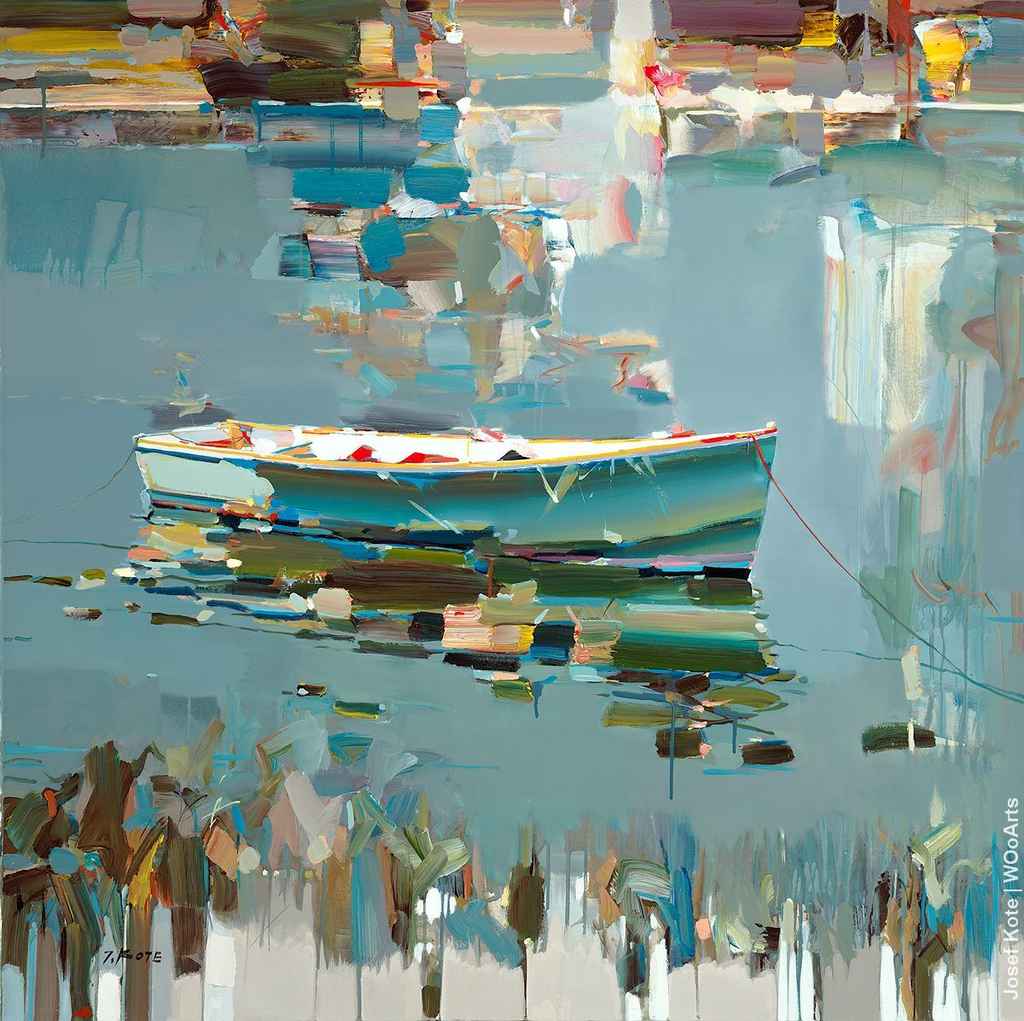
As with many of his other portraits later on in his career, Kote leaves much of the background sparse and abstracted, honing in on his subject, striking a balance between realism and abstraction in order to bring attention to the necessary elements and grant his viewers the ability to peer deep into the subject at hand.

The background behind Stephanopoulos is soft and neutral, almost matching him in tone, with only blend of deep red and golden hues emanating from his left side to give it a pop of color. It is in these details that the style that comes so naturally to Kote shines through, and illustrates his continual desire to merge classical and modern. Of course, there is seemingly no more appropriate place to do so than in two works that are meant to illustrate this same unity in Greece on a larger scale.
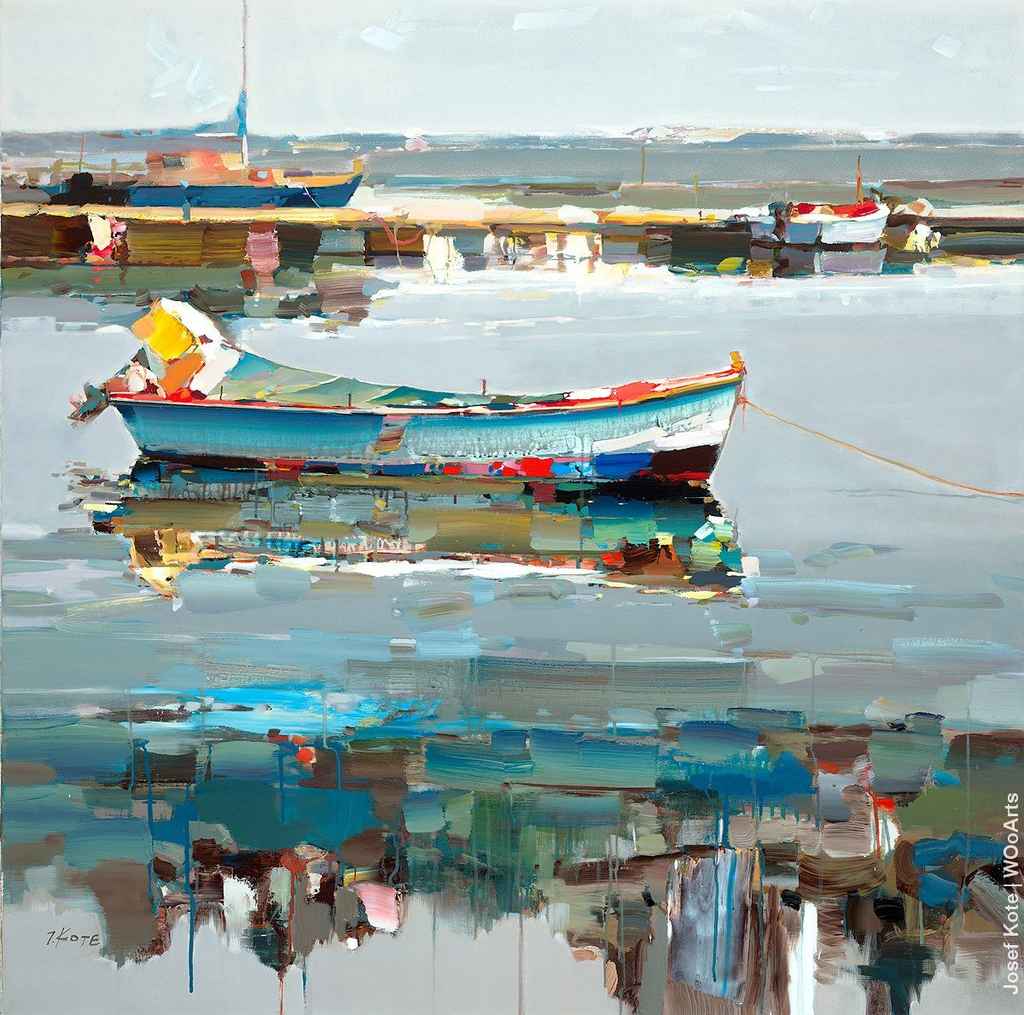
After a fruitful ten years in Greece, Kote again grew restless. Kote made his way to Canada, where he stayed for almost a decade. Once again, Kote’s daily surroundings provided countless sources of inspiration. Known for its harsh and intense winters, this period of his oeuvre reflects the snowy landscapes of the Great White North.

Seamlessly, the colors of this period cool from the sunny yellow glow of the Mediterranean to a crisp, powerfully bright white. So too the very nature of his landscapes shift during this period of his life. Bright, sunny landscapes and marine pictures give way to the vast expanses of Canadian forest and the quaintness that exists in even a major city such as Toronto.

It is in one of his paintings from this time that this shift is really made clear. Rendered horizontally, the land presented to us seems to extend on forever, punctuated by the smooth sheen of snow that blankets the subtle incline of land.

It is in this space that Kote’s masterful use of the negative space is given room to shine through. Monochromatic in tone, with only soft subtle shifts in the white he renders, Kote guides his viewers eye from the foreground to the background, winding through the trees and continuing on, seemingly, forever.

Amidst the expanse of snowy ground, thin tree trunks spring up, almost entirely bare the closer to the viewer they appear. Extending from the top to the bottom of the canvas, they anchor the composition, filling out as the viewer’s eyes move further into the landscape. In these sections, onlookers get a glimpse of Kote’s other signature techniques – his dripping effect and his expressionistic brushwork.

The trees feel like faint remembrances; they are not decidedly there, definitively placed by the artist. Instead, they seem to emerge as if being recalled from a time now past. Earthy tones of burnt orange, maroon, deep blue, light gray, and even hints of black coalesce to form loose ideas of trunks and leaves. It is only as rivulets of color drip down the canvas and merge with one another that these forms begin to take shape. Clearly, Kote is capable of adapting his masterful techniques to a wide-range of subjects.

Then, in 2009, Kote moved again, this time to New York. Like so many artists before him, and so many that will follow after, he was inspired by the vibrancy and energy of the city, and this was channeled into the work that he has produced over the near decade he has lived there.

Leaving the snowy expanses of Canada behind, Kote’s work took on a new life. Naturally, his subject matter shifted to match this new dynamism around him. Landscapes made way for more urban cityscapes, and his practice moved almost exclusively indoors to the studio as the scale of his canvases increased to match the height of the skyscrapers New York is so well known for.
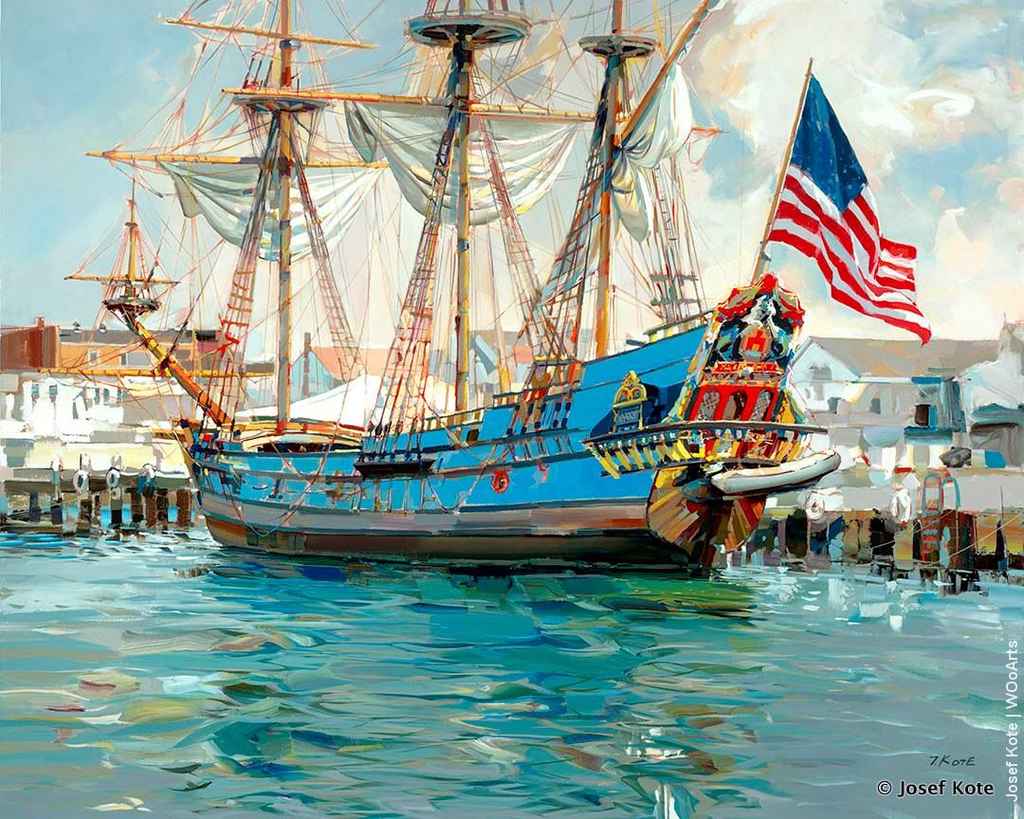
Known equally for the liveliness of its people as well as the height of its buildings, Kote’s oeuvre in the past decade has seen a large outpouring of portraits. Primarily of his daughter, with these paintings Kote is able to capture a wider range of emotions and further explore the possibilities of paint handling, pushing his own practice further.
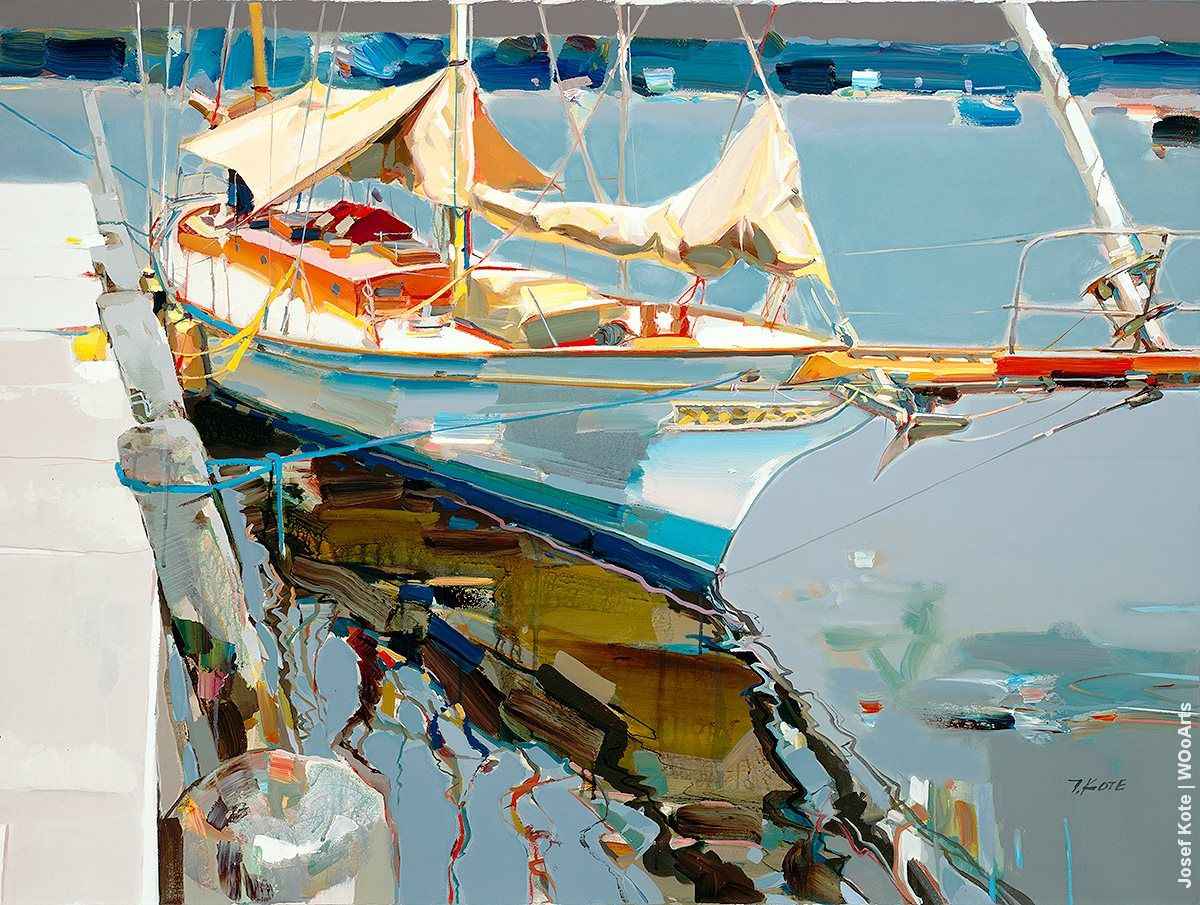
One of the most vibrant and emblematic works of this move to New York is his painting Exquisite Beauty NYC. At 48 x 48 inches, its size can only hint at the truly massive size of the buildings it depicts, but Kote skillfully renders this sense of scale for his viewers.

Inspired by the cultural richness and the architecture of his new surroundings, Kote took a number of photos and sketches that acted as references for the composition as he worked in his studio. For this particular painting, Kote’s focus was on creating a sense of depth, which one finds through the diagonal line of buildings that draws one’s eye across the canvas and further down the streets of New York City.

At the lower register, cabs and cars dart by, almost a blur as they whiz past, characteristic of the fast pace at which the city thrives. Here Kote is able to show off his expressive brushstrokes, as quick flecks of yellow and red lend a sense of movement to the vehicles. This sense of rapidity is echoed in the buildings, which are not rendered in perfect detail, but instead utilize Kote’s signature dripping effect to allow lines in the architecture to appear, letting viewer’s eyes fill in the rest as they take in the vibrancy of the scene before them.

In Follow Your Bliss, also created since Kote has moved to New York, one gets to see how his techniques translate to portraiture in a way that can be freer and more expressive than the state portraits he did during his time in Greece. Here, his daughter, Angela, sits beside a window, gazing out to the outside world – what she is looking at, the viewer can only guess at.

Yet, whatever it is, Kote has captured within her gaze a sense of contentment, as if she is happily lost in her own world. In Follow Your Bliss, the sitter is truly the beginning and the end of the composition; save for the window, which Kote depicts just enough to give a sense of what is happening in this scene, there is nothing else on the canvas to draw the viewer’s attention towards.

Whatever may be happening outside can be gleaned only from her face, whether that be through the emotion in her eyes or the warm light that illuminates her face, hair, and collar bone, all of which is emphasized through pure white strokes on her skin and the mingling of oranges and red that flit through her hair.

The lower portion of her body, her dress, and hands begin to lose detail as the eye moves down the canvas, drawing us back upwards to where the internal action is taking place. Kote’s paintings are like memories, like time stood still, and those elements which are not essential to the memory appear as merely traces.

While Kote strives to create a definitively unique style that is undoubtedly his own, he is not without certain art historical precedents. Indeed, this is part of what makes Kote such an adept painter – by taking what has come before him and transforming it into a style that is inherently tied to him as an artist, he manages to fulfill his own unique needs while simultaneously driving the long and complex history of painting further into new realms.

It has been stated before by art historians of the past, most notably in the 1960s and 1970s, that “painting is dead,” and yet Kote, and the artists from which he takes his cues, have proven that this is anything but true.

Looking at Kote’s work, two distinct ideas in art history come to the fore: that of abstraction versus realism, and the notion of painting as representative of feeling or experiences. Much of the way we view these ideas in art now, and much of the way Kote works, can find their beginnings at the end of the nineteenth century with the Impressionists.

A result of multiple social, economic, and artistic factors, such as the Industrial Revolution and the invention of ready-to-purchase tubed oil paints, the Impressionists began to see and depict their ever-changing surroundings in increasingly new and inventive ways. Working en plein air as a result of these new innovations in paint production, as Kote himself so often does, artists such as Monet, Renoir, and Van Gogh began to focus less on the specifics of the landscape around them.
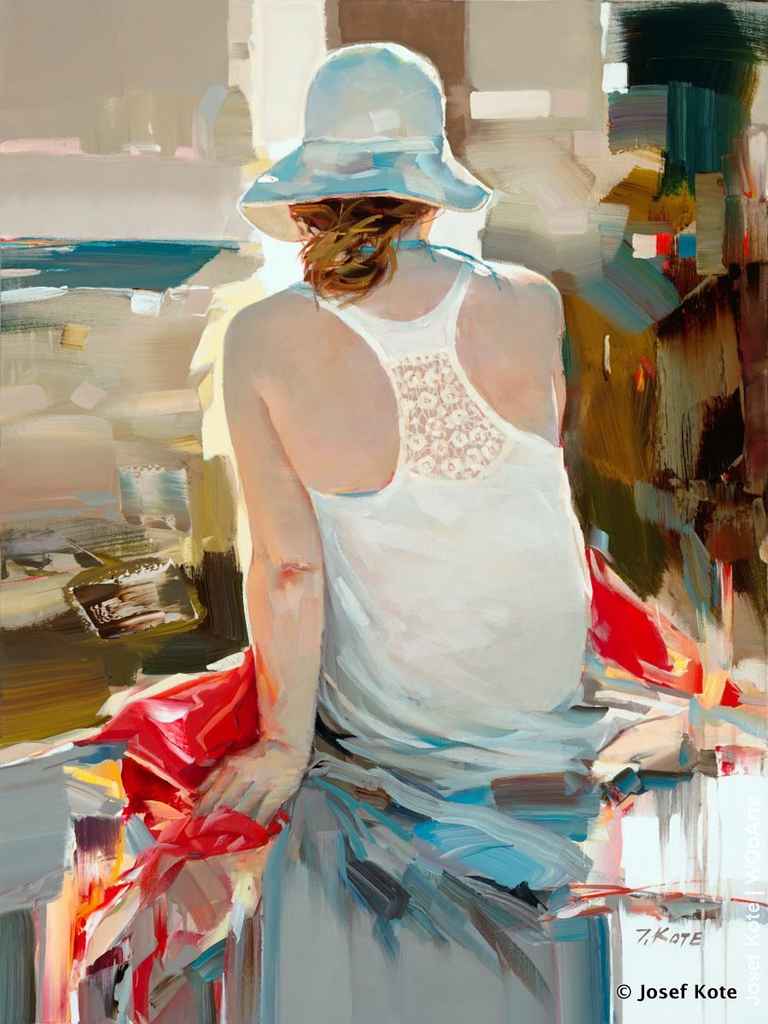
Instead, their interests lived in the in-between moments, in the states of flux that the world constantly exists in, as the name of the movement implies. In much the same way, Kote does not give his viewers exacting, clear details. Instead, he lets the general impression of the scene that has inspired him – whether a seascape, or a moment of his daughter – guide his brush.
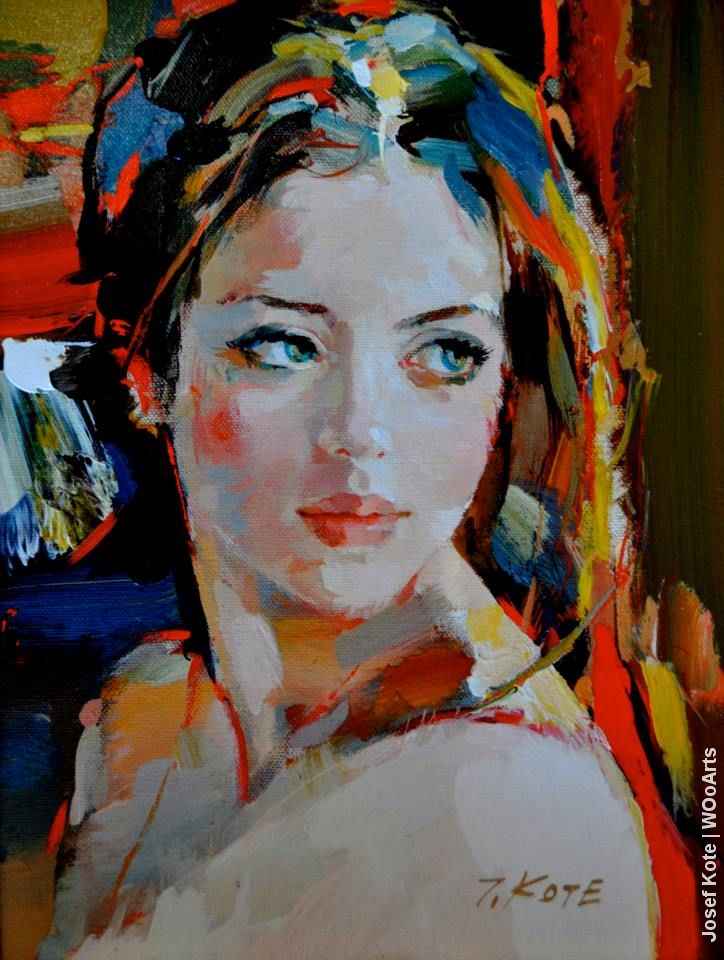
By not relaying the minutiae of these moments, Kote, like the Impressionists, allows his viewers ample space to fill in the missing elements, to evoke their own feelings and to understand the fleeting nature of these moments that we can only attempt to keep forever in paint.

This radical departure from the tradition of art history that had pervaded painting for hundreds of years captured the minds of more than just the Impressionists or Kote, and it can also be plainly seen in Kote’s oeuvre the multitude of ways these further inventions in abstraction and emotive depictions have influenced him.

Wassily Kandinsky, perhaps the first true abstract painter, has a number of similarities and influences as Kote. Most notable of these is the influence music has on both artists. Kandinsky viewed music as the most transcendent form of art, and his life’s work was in large part an attempt to create a similar effect that sound produces in paint.

From titling his works in ways that hinted at music, such as his series of “Compositions” or “Improvisations,” to the very compositions themselves, springing forth with energetic lines that look almost like notes on a musical staff and colors that harmoniously flow together like chords, music was in everything Kandinsky did.
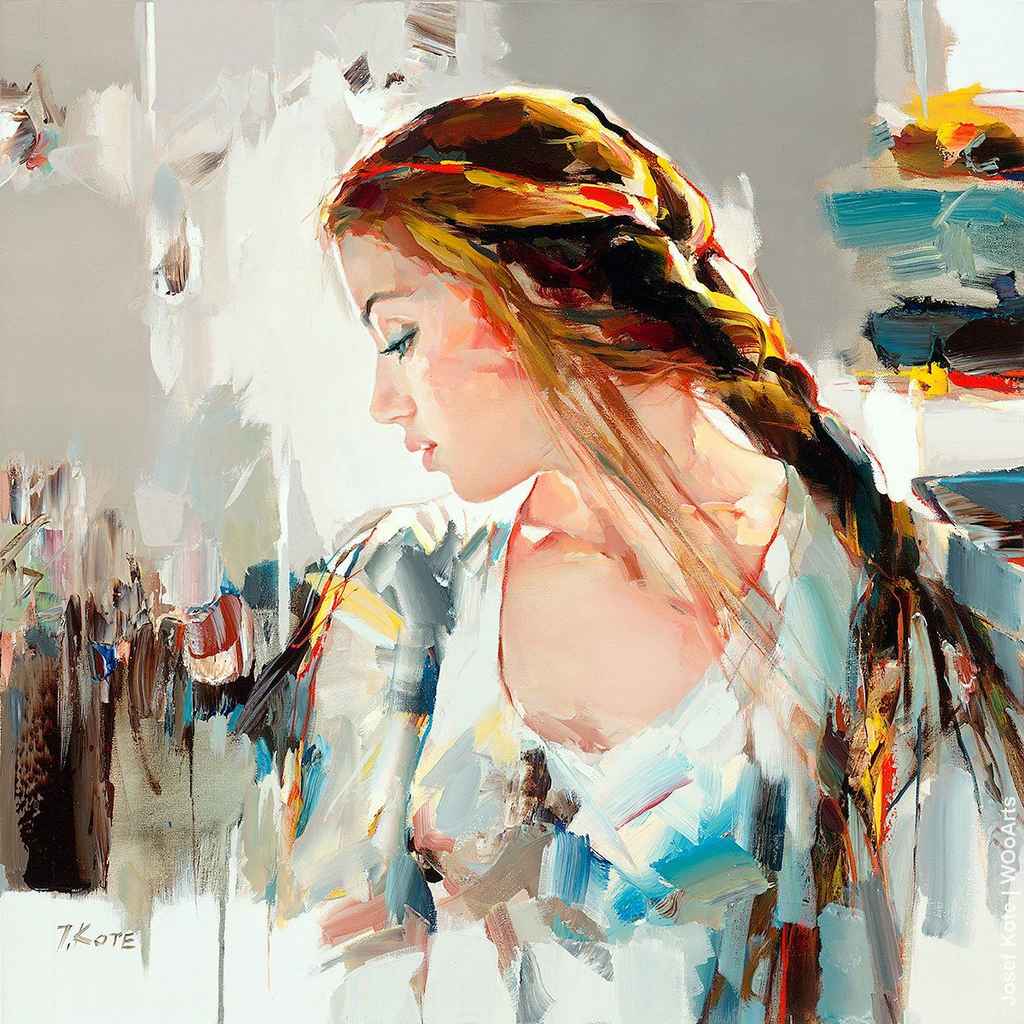
In much the same way, Kote is deeply inspired by music, which has played a key role in his life. Starting music lessons at age twelve, Kote toyed with the idea of becoming a musician, before discovering painting and shifting his career plans.

To this day, he spends much of his time in the studio listening to classical music as he paints, and he cites this as an instrumental part of his creative process.

As Kote has stated in interviews, his interests lie more in depicting an emotion or feeling than in a direct depiction of what he sees. Perhaps the apex of this idea of using art to relay an emotional state occurred just after World War II in New York amongst a group of artists known as the Abstract Expressionists.

Kote has cited a key member of this movement, Willem de Kooning, as a strong inspiration on his art, and it is easy to see why. Similarly to Kote, de Kooning’s work, such as the famous Woman I that hangs in the Museum of Modern Art in New York blurs the boundaries between representation and abstraction.
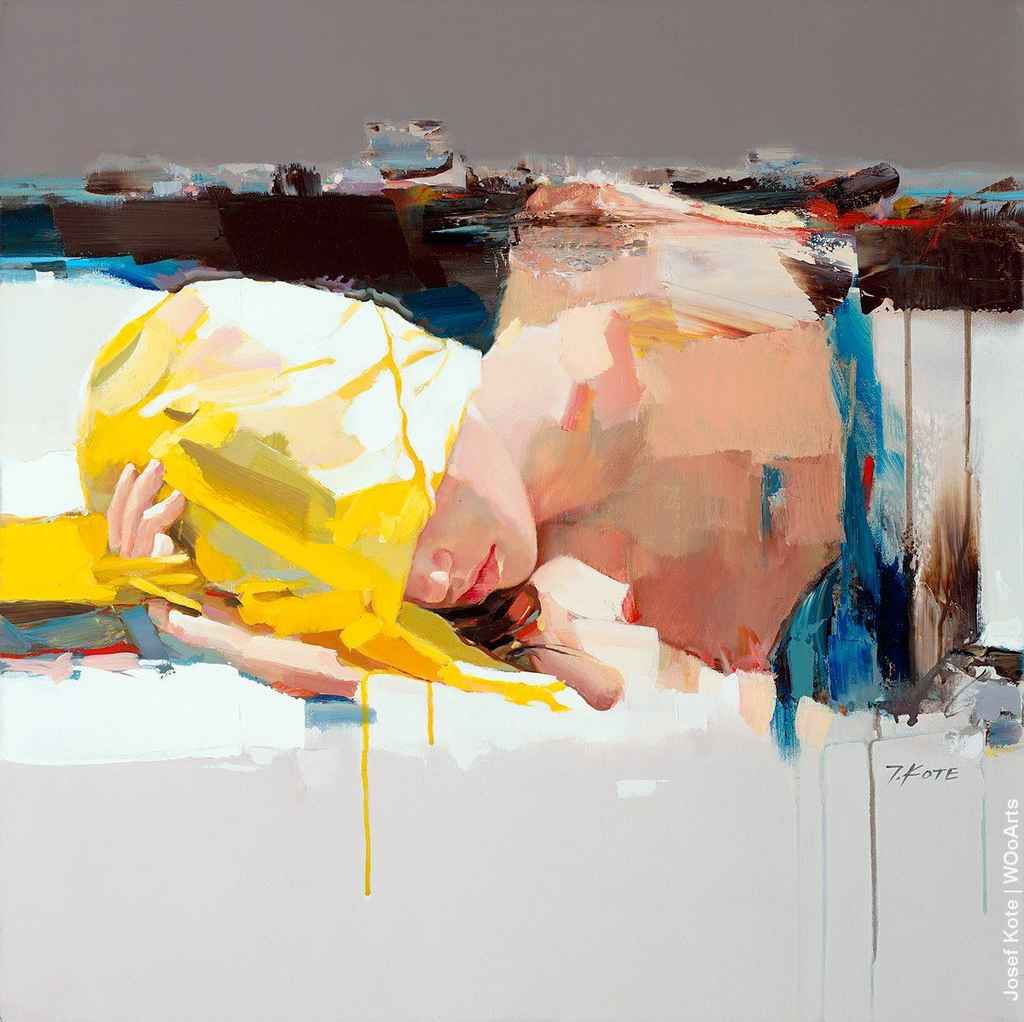
In Woman I, a flurry of brushstrokes in green, blue, pink, yellow and black build up to form an energetic background, and through these brushstrokes a woman emerges in the center of the canvas.

Importantly, this woman that reveals herself to us is not a realistic depiction, for not only is her form primarily a result of the built-up background, conflating foreground and background, but she is far from being the type of woman most people have seen in their day-to-day lives.

In this way, de Kooning bridges abstraction and realism, hinting at the idea of the female form without ever truly depicting it. In much the same way, one can look at a painting of Kote’s, such as The Voice Within and see the influence this kind of painting has had on the artist.
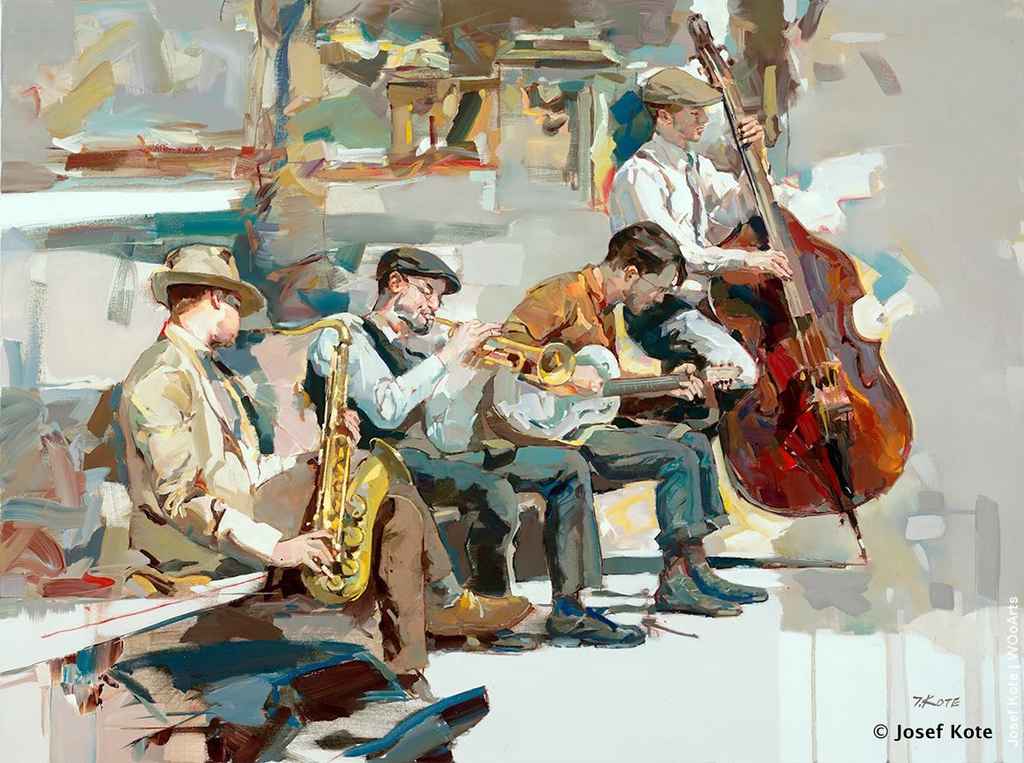
Like de Kooning, Kote toggles between realism and abstraction, although Kote gives his viewers more to work with as far as grounding his images in reality, and the two artists share a masterful ability to create a deeply rich and interesting composition.

Moving in to today’s artistic landscape, few artists work in a style quite like Kote’s, but one artist that continually comes to mind is the artist Peter Doig. Scottish-born and Trinidadian-based, Doig, like Kote, has constantly moved around the world, and these varying landscapes and the memories they provide continually influence his work.
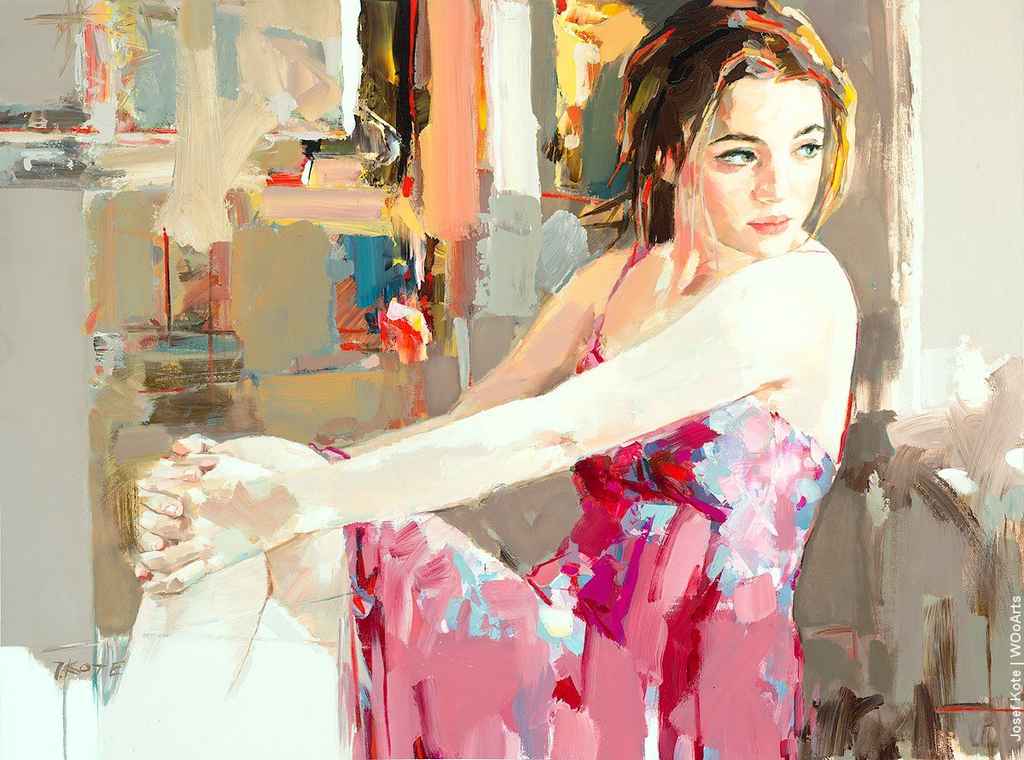
Having spent a little over a decade in snowy Canada, Doig’s practice continues to be informed by these vast landscapes. Again, like Kote, Doig often works from photographic references and, instead of using these to depict absolutes, he uses them as a jumping off point for abstracted landscapes that feel like distant, hazy memories.

There is something serene about the work of both artists, something that feels as if you have seen these landscapes a thousand times before, and yet you can quite make them out vividly.

A remarkable force of a painter, Kote’s singular artistic vision has managed to sustain him for his entire career, providing a deep, rich and prolific body of work. Forever inspired by the world around him, he has shown keen insight into the nature of existence and given viewer’s a unique opportunity to contemplate and appreciate their surroundings, seeing them in a new and fresh way. As with any artist, Kote will undoubtedly continue to grow and flourish, and it will be nothing short of exciting to see where this takes him.

